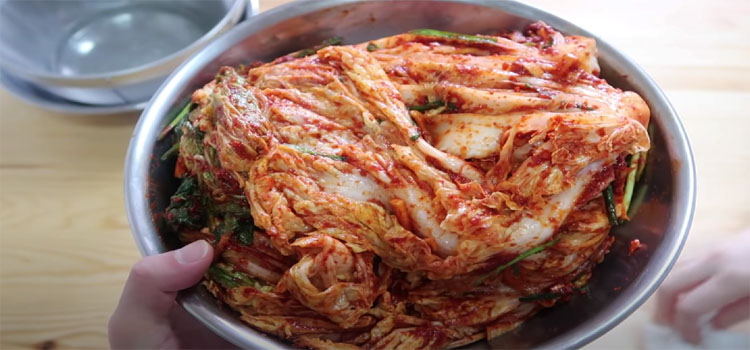Last Updated on September 16, 2024 by Shari Mason
Kimchi, a **beloved Korean dish**, always **sparks curiosity** because of its unique fermentation and long shelf life.
From my own culinary explorations, I’ve discovered that understanding when kimchi might be past its prime is a skill developed over time. The shifts in aroma, taste, and even its visual appearance can offer valuable hints about its freshness.
I’ll show you how to tell when kimchi is bad in this guide. Read on.
How Can You Tell When Kimchi Has Gone Bad?
Kimchi can go bad if it develops an off-putting smell, unusual texture, or mold.
“I love kimchi. The biggest influence that eating so much Korean food growing up had on me was that I have no limit for spiciness. The hotter, the better.”
– Patrick Stump, American Musician
If it smells overly sour or fermented, has a mushy texture, or shows signs of mold growth, it’s best to discard it for safety.
Read:
- How Long Is Cucumber Kimchi Good For?
- How To Tell If Just Egg Is Bad?
- How To Tell If Scallops Are Bad?
- How To Tell If Shredded Cheese Is Bad?
Does It Smell Off?


When assessing the freshness of certain foods, your nose can often be your best ally. A deviation from its normal, tangy, and fermented aroma can indicate that the kimchi has gone wrong.
If the scent veers towards an overly sour, spicy, or even moldy smell, it’s a clear sign that the kimchi is no longer suitable for consumption.
Always trust your instincts; if something smells off, it’s better to be safe and discard it.
Has The Texture Of The Kimchi Changed Dramatically?
Kimchi’s texture is another crucial indicator of its freshness. Fresh kimchi possesses a crisp bite, accompanied by the pleasant chewiness of well-fermented vegetables.
However, when the kimchi [1] has gone bad, you might notice a slimy or excessively soggy texture devoid of that characteristic crunch.
Such a dramatic change in texture often implies an overgrowth of undesirable bacteria or mold, rendering the kimchi unsuitable and potentially harmful for consumption.
Are There Any Visible Molds or Unusual Colors?
The appearance of kimchi can offer vital clues about its credibility.
While a naturally fermented kimchi may go through color transitions as it matures, turning from a vibrant red to a more muted hue, any visible mold or unusual spots is a clear sign of spoilage.
Mold may manifest as white, blue, green, or even black patches on the surface or within the layers.
Additionally, any discoloration that deviates from the typical spectrum of kimchi shades, such as brownish or grayish tints, should raise red flags.
Does The Kimchi Taste Too Sour or Off?


As a fermented food, kimchi will naturally develop a tangy flavor as it ages.
However, there’s a distinct difference between the sharp, pleasant acidity of well-fermented kimchi and an overpowering sour or off-taste that signals spoilage.
“Like a symphony gone awry, when kimchi’s vibrant notes turn flat and its lively colors dim, trust your senses; it’s time to let it go.”
– Eat Pallet restaurant & Food Advice
If, upon tasting, the kimchi has an extreme sourness that masks all other flavors, or if it presents any other off-tasting notes that are unfamiliar or unpleasant, it’s possible that the fermentation has gone awry or the kimchi has begun to spoil.
Has The Kimchi Been Exposed To Air For Extended Periods?
When the kimchi is left open to the air for extended periods, it allows for the introduction and proliferation of unwanted bacteria and molds, potentially disrupting the desired fermentation process.
The oxygen [2] in the air can cause the kimchi to oxidize, changing its color, flavor, and texture. Moreover, continuous exposure can dry out the top layers, making it less tasty.
To maintain the freshness and integrity of kimchi, it’s crucial to ensure that it’s stored in an airtight container and any excess air is pressed out, keeping the vegetables submerged in their juices, which act as a natural preservative.
FAQs
u003cstrongu003eWhat does spoiled kimchi look like?u003c/strongu003e
Spoiled kimchi can exhibit mold growth, unusual colors (brown, gray), slimy texture, and an overpowering sour or off taste.
u003cstrongu003eWhat are the white spots on my kimchi?u003c/strongu003e
White spots on kimchi can often be a sign of natural yeast formation during fermentation. These spots are generally harmless and can be a regular part of the fermentation process. u003cbru003eu003cbru003eHowever, if the white spots appear fuzzy or have a moldy texture, it could indicate mold growth, a sign of spoilage.
Final Thoughts
Be vigilant when storing and consuming kimchi, as it can spoil quickly due to its high acidity and salt content.
To tell if the kimchi has gone bad, look for visible signs of mold or an off-putting smell, and discard the kimchi accordingly.
Additionally, pay attention to the expiry date on the container and ensure you eat the kimchi within a few days after opening.
Proper care and storage allow you to confidently enjoy your kimchi without worrying it doesn’t go well.
References:
- https://www.allrecipes.com/recipe/269166/traditional-kimchi/
- https://pubchem.ncbi.nlm.nih.gov/compound/Oxygen
- Can You Put an AC Unit in the Kitchen? - September 27, 2024
- What Cheese Does Olive Garden Use? Discover Their Signature - September 27, 2024
- How to Cancel a Pizza Hut Order? Quick & Easy Guide - September 24, 2024


